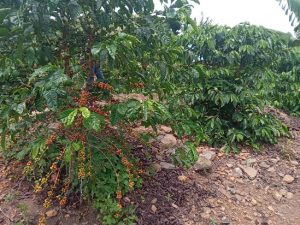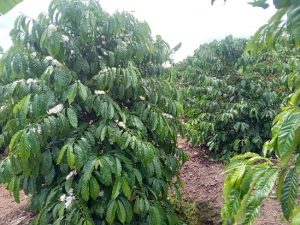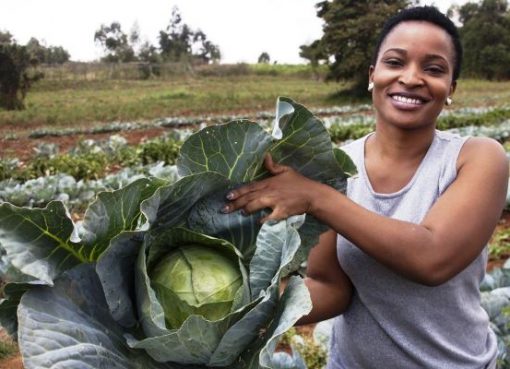Kaahwa has turned a rocky area into a fruitful coffee farm
Coffee can easily grow on any soil type in Uganda if Good Agronomic Practices (GAPs) are applied. That’s a quick conclusion you will make after visiting Geoffrey Kaahwa Byalelo’s coffee farm which is located approximately eight kilometers east of Hoima City.
You’ll also agree with Uganda Coffee Development Authority’s decision to recognize Kaahwa as the Outstanding Coffee Farmer, 2023 for Western region during the recent Annual Coffee Platform Stakeholders’ Meeting held at Mestil Hotel, Kampala.
UCDA’s Western region comprises of 11 districts including Hoima, Buliisa, Masindi, Kiryandongo, Kibaale, Kagadi, Kakumiro, Mubende, Kassanda, Kiboga and Kyankwanzi.
Located in Mbogwe Cell, Nyakambogo Ward, Hoima East Division in Hoima City, the 17-acre coffee farm sits on stony murram land with a steep slope. It is a joy to watch and tour as it offers life-changing lessons for coffee farmers.
A look at the rocky area leaves one wondering how Kaahwa,59, turned the area into a lush green, healthy and bountiful coffee plantation that is attracting visitors from near and far.

Kaahwa’s coffee is at different stages of growth, with the youngest block set to make three years in April 2024, while the oldest is 10 years. This means all the 17 acres are productive. Kaahwa’s coffee farm does not have shade trees but it is inter-cropped with bananas (matooke) which he says provides the coffee trees the much-needed shade.
“Each matooke plant must have only three suckers including the mother and each plant covers four coffee trees,” Kaahwa says.
Inspiration
Kaahwa joined commercial coffee farming 10 years ago because of his background in coffee.
“My father was a coffee trader at a local level. He also inspired me into coffee trading. As a coffee trader, I was particularly challenged by small-scale farmers with about 10 coffee trees who would get some good money from the few trees. I thought I would earn a lot more if I planted coffee on a large scale,” Kaahwa told Business Focus.
When Kaahwa decided to start farming, he looked for a crop that “can transform one’s life for good and coffee came up as number one.”
“I started with 100 elite seedlings to test the suitability of the soil and have been expanding since. I have about six acres of elite coffee,” he says, adding that the other 11 acres are covered by Coffee Wilt Disease Resistant varieties commonly known as KR varieties.

He uses the standard spacing of 3m by 3m as recommended by UCDA. This means he has a total of 7,650 coffee trees. He has been using his savings to buy the coffee planting materials.
Climate-Smart Farming
Asked how he turned a rugged stony murram hill into an oasis of a fruitful and productive coffee hacienda, Kaahwa said he religiously follows Good Agronomic Practices concerning coffee growing.
“Unlike some farmers, we make standard holes (2ft by 2ft). Given that we are in a hilly area, the farm is covered with trenches to control soil erosion and conserve water. Before we introduced the trenches, the coffee would be hit badly by the dry spell. The trenches have made a big difference,” Kaahwa explains.
The trenches are about 45cm (width and depth) and about 300m to 400cm (3 to 4m) long across the slope. The different water conservation trenches are separated by about 100 to 150cm.

The un-trenched portions are used as walkways but also to allow excess water to flow down the slope to find the next staggered contour trenches.
Kaahwa also applies manure (cow dung) and inorganic fertilizers to boost the fertility of his soil.
He buys cow dung from as far as Kyankwanzi and mulches his coffee as much as possible so as to create more humus.
He spends an average of Shs 10m on fertilizers annually while farm maintenance costs Shs 1m per month on average.

Another climate-smart innovation to conserve water is the way each coffee plant is seated within a shallow ‘soil basin’ that allows water and nutrients to linger within the root zone of the plant long enough to nourish it.
“When back-filling the hole, we do it quarter way and plant our plantlet. As the coffee grows, we try to maintain that basin-like-hole,” Kaahwa says, adding that he also applies coffee husks to each coffee plant root zone every three years.
The farm employs two workers on a permanent basis. Several others are temporary earning on a piece rate basis.
Yields and Earnings
Kaahwa says coffee requires enough water (irrigation) if one is to maximally benefit from it.
“On average, a coffee tree of over five years that is under irrigation can give you about 10 kilograms of kiboko (dry coffee cherries) or six kilograms of kasse (Fair Average Quality),” Kaahwa says, adding that keeping coffee weed-free is also key. He weeds his coffee and then uses herbicides and slashing on the weeds left in between the rows.
Kaahwa believes coffee is profitable because one can easily earn a gross profit of Shs 9m per year from an acre.

“It’s very possible to earn Shs 20,000 per tree per year but one can earn a lot more if GAPs are observed,” he says. He reveals that without irrigation, he harvested 180 bags of dry cherries last season, but with irrigation and most of his coffee reaching peak production, he hopes to harvest more bags to boost his income.
Kaahwa says besides being a source of food for his family and workers, the matooke also gives him money which he uses to pay some workers.
Irrigation
In March this year, Kaahwa installed a concrete water tank reservoir of 30,000 litre-capacity to maximise production. The water is pumped into the tank from a production borehole using a single-phase electric submersible water pump.

During the dry season, the water is released in a controlled manner through a piping system to irrigate the coffee plantation by gravity flow using movable hand-held irrigation hoses.
Kaahwa says the system cost him about Shs70m.
“With irrigation and the trenches in place, we hope our productivity will increase,” he says.
Challenges
He says one of his biggest challenges is coffee drying especially during the rainy season. He also finds difficulties in harvesting the coffee as manpower is sometimes not readily available. He pays between Shs 100 and Shs 200 per kilogram harvested.
“When the harvesting season has reached the peak like it is now, we pay Shs 100 per kilogram harvested but when the season is starting or ending, we pay between Shs 150 and Shs 200 per kilogram of red cherries harvested,” he states. He dries his coffee on tarpaulins to ensure quality.

Dealing with the Coffee Black Twig Borer is a major challenge that Kaahwa faces, like many other Robusta coffee farmers. He however says healthy trees are less susceptible.
“We are intensifying the feeding so that our coffee is all healthy,” he says, adding that there are also many substandard pesticides on the market which farmers must know and avoid.
“At the moment, we cut and burn the affected twigs before spraying with recommended pesticides,” he says on how they are managing the devastating Black Coffee Twig Borer.
He reveals that elite coffee is being affected by the coffee wilt disease and his only solution is to replace the affected trees with KR varieties.
Benefits
When Kaahwa started growing coffee, he never imagined he would become a model farmer in Bunyoro region.
“Being a model farmer in the region is no mean achievement for me. Every day we get people coming to learn about coffee farming. I’m now known not only in Hoima and the region, but across the country,” he says, adding: “Recently UCDA recognized me as the best coffee farmer in the region. I thank them for recognizing and supporting me. This has motivated me to even do better,” he says.
He adds that he has a large family that he is taking care of using coffee revenues.
He thanks UCDA for moving the regional office from Mityana to Hoima, noting that it has been a game-changer for many farmers.
“UCDA extension officers have been giving me priceless tips and support. I’m at this level because of them,” he says.
Advice to farmers
Kaahwa says if you are not ready to give your coffee love and attention, don’t waste your time and money to venture into it.
“You might have an office job and want to venture into coffee farming. That is good. But you must spare time to inspect your farm and address the issues arising,” he says, adding that one must also be ready to invest in the coffee especially buying fertilizers in the initial years before the farm becomes self-sustaining.
Future Plans
Kaahwa says he plans to continue expanding his farm to at least have 40 acres of coffee by 2030 and 50 acres by 2035. He has already acquired the land for expansion. He believes the earnings from the already productive coffee will support the expansion.

“Next year I want to plant three acres, then 10 acres in 2025 and I will go on planting in a phased manner,” he says.
Value Addition
Kaahwa plans to buy a coffee huller to add value to his coffee once he reaches 40 acres. At the moment, he hulls his coffee from millers and sells graded coffee.
“My coffee is mainly Screen 18 and 15. We even get Screen 20,” he says, noting that Screen 18 forms 70% of his coffee.
UCDA’s Support
Mathew Katash Kwikiriza, the UCDA Regional Manager in charge of Western region, says UCDA has motivated Kaahwa to improve on his practices at the farm.
“We advised him to dig trenches to harvest rain run-off water and he obliged. Initially, he feared stumping his coffee but after a small demonstration performed well, he’s willing to stump coffee that grows older and becomes less productive,” Kwikiriza says.
He describes Kaahwa as “an early adopter who listens and practices what we tell him.” He says UCDA has further supported Kaahwa with inputs like fertilizers, insecticides and fungicides to demonstrate Good Agronomic Practices and make him appreciate that the issues at the farm are manageable if a farmer uses the right inputs.
“He (Kaahwa) was initially not grading his coffee but after UCDA’s advice on value addition, he started grading his coffee and is able to sell his coffee at a better price,” he says.
Kwikiriza says Bunyoro contributes about 300,000 60kg bags of coffee (FAQ) to the national production per year.
He adds that there has been an improvement in the quality of coffee from the Western region since 2020 due to continuous sensitization on the benefits of quality coffee.
He encourages farmers to always ‘restock’ their farms.
“When you harvest coffee from these trees, you have taken out stock. You also need to have some money brought back to the farm to restock by buying fertilizers, making sure your farm is weed-free throughout and if possible, investing in water (for production) because going forward it’s going to be hard for us to farm without irrigation,” he says.
He urges farmers to always pick only red ripe cherries, noting that harvesting unripe coffee causes untold losses to the farmer.
“Unripe coffee spoils the aroma of the coffee we drink; it spoils the taste of the coffee on the tongue and heavily reduces the weight of the coffee that the farmers would be getting from their crop. Farmers should be patient and harvest it when it’s ripe and heavy,” he says.

Kwikiriza adds that some traders/middlemen give out loans to farmers after coffee has just flowered and end up harvesting unripe coffee fearing that the farmers could sell the coffee to other buyers.
“This affects the quality of coffee Uganda exports. I urge them to stop these bad practices that are keeping small scale farmers poor,” he says, noting that if they don’t stop, the long arm of the law will soon catch up with them.
It should be noted that the National Coffee Act 2021 gives tough penalties to different categories of people for compromising the quality of coffee.
For tips, opinions and advertising, Tel: 0775170346/0703828741/staddewo@gmail.com. Follow us on Twitter: @TaddewoS @BusinessFocusug








Geoffrey Kaahwa’s farm has inspired me. I’ll also begin with one acre.
This is giving more hope to farmers, this article once read by the so called “youth”, their hopes should be energized through farming, especially coffee and banana. Thanks Mr author.
I am very happy and proud that we have examples of farmers who inspire us on Coffee in the Hoima region.
I am an upcoming coffee farmer myself and will make an effort to visit Mr. Kaahwa’s farm to learn from him as well.
Thank you for the efforts in making your farm a Model farm and thanks to UCDA for the support to this farmer.
Good work and promising